30/11/12
28/11/12
Silla libro.
Simple pero complejo.
Un poco de autos para los pibes!
MERCEDES-BENZ ENER-G FORCE CONCEPT CAR- 11.28.12
 Mercedes-Benz Ener-G Force Concept Car - it’s like the cartoon super hero car that someone between the Fisher Price Rescue Heroes/Team Fortress/Duke Nukem would drive… with an Xterra-esque rear, an FJ like feel, and the illustrations remind me of Kimberly Wu’s JOY concept from 2008. While I was intrigued by the concept images that have been floating around when it surfaced on NOTCOT.org, i didn’t expect to love it as much as i did in person! The sketches are stunning. The attention to details - fascinating! And in person, in the glow of sunset, it really is hard to take your eyes off of. I love that they created the concept and sketches situations of it for Desert, Polar, and Jungle situations using camel, penguin, and monkey icons - even on the tires, which sadly didn’t make it into the final model. However, they did slip in the side view mirror warning: “Penguins, camels, and other wild animals in mirror may be closer than they appear.” Mercedes, please make this into a toy car model - or an R/C car - or a 3D printable R/C car shell… because it is adorable, and would make for some ridiculously fun photoshoots with action figures.
Mercedes-Benz Ener-G Force Concept Car - it’s like the cartoon super hero car that someone between the Fisher Price Rescue Heroes/Team Fortress/Duke Nukem would drive… with an Xterra-esque rear, an FJ like feel, and the illustrations remind me of Kimberly Wu’s JOY concept from 2008. While I was intrigued by the concept images that have been floating around when it surfaced on NOTCOT.org, i didn’t expect to love it as much as i did in person! The sketches are stunning. The attention to details - fascinating! And in person, in the glow of sunset, it really is hard to take your eyes off of. I love that they created the concept and sketches situations of it for Desert, Polar, and Jungle situations using camel, penguin, and monkey icons - even on the tires, which sadly didn’t make it into the final model. However, they did slip in the side view mirror warning: “Penguins, camels, and other wild animals in mirror may be closer than they appear.” Mercedes, please make this into a toy car model - or an R/C car - or a 3D printable R/C car shell… because it is adorable, and would make for some ridiculously fun photoshoots with action figures.
Take a look at the sketches, details, teaser video (the video is pretty epic) - then the unveiling of the full sized model at Mister C in Beverly Hills tonight. There are a LOT of pictures, but there was too much fun not to share! See it all on the next page…



You HAVE to check out this video!
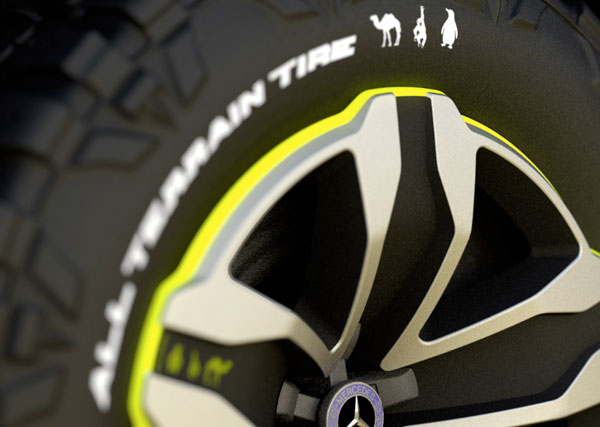



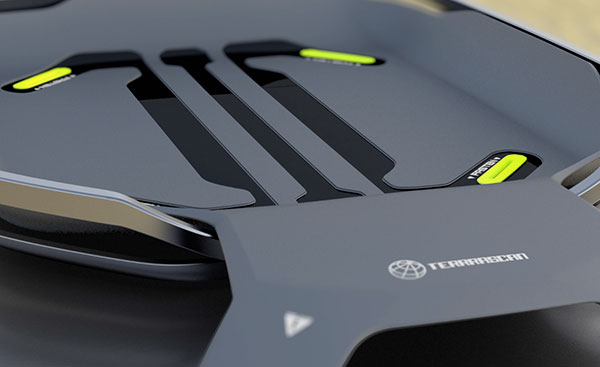
At the unveiling at Mister C in Beverly Hills - it is really even prettier in person!






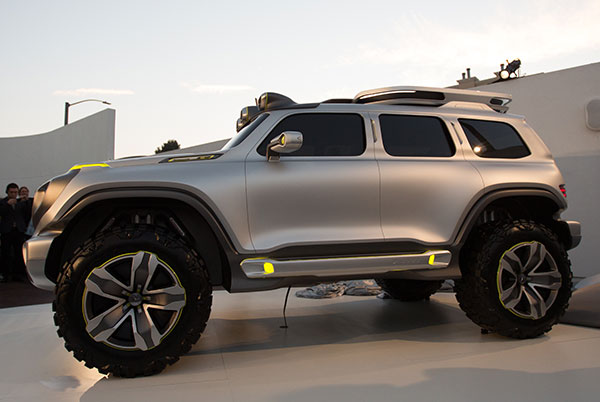









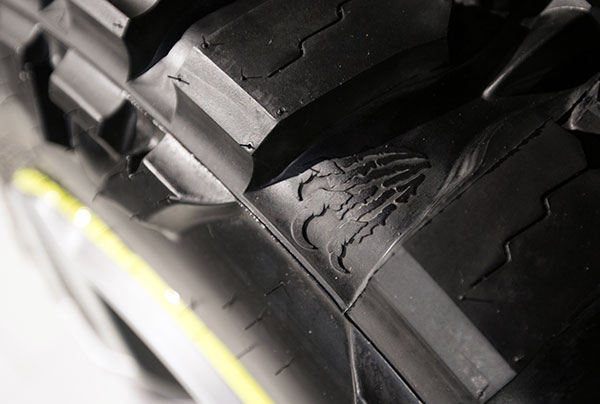
Here’s who i imagine driving it…
26/11/12
Engranajes muyyy extraños.
Posted by hipstomp / Rain Noe | 17 Feb 2012 | Comments (9)

Whether I listen to my brain, or my heart, I still
don't understand how these damn things work
don't understand how these damn things work
When I told my Graphic Design professor that I wanted to transfer to a school offering Industrial Design, she warned me "Well, if you're going to study ID you're going to have to be able to flip things around in your head, you'll need a strong grasp of 3D." Luckily I had it, and after I made my transfer, orthographics became second nature.
That was years ago, and orthographics, of course, are not true 3D. And looking at things like cube gears makes me realize how mediocre my 3D processing abilities are.
Cube gears and heart gears, which first made a YouTube splash in 2008, have more recently been propagated by 3D-printing Thingiverse guys likeemmett and faberdasher. And just when I think I'm getting my head around how they work, I come across "paradoxical gears:"
They're side by side, and yet they all turn in the same freaking direction. My brain almost broke looking at them. I figured that the guy who invented these surely used some sophisticated 3D software that artificially boosted his capabilities, like some engineering version of steroids. Then I found out it was patented way back in 1988 by a Renault engineer named Mercier. Not a lot of 3D workstations around back then (though it's possible).
To make myself feel better, I dug up some videos of innovative gears that I actually can understand, as these operate in a more comprehensible two-dimensional way. Check out this gear system that changes speed:
Simple but clever. Along the same lines is this gear system that changes direction:
While I can't understand the in-video Mandarin commentary, I can understand the English comments written beneath the video. "How the f___ do you end up on videos like this?" writes one presumably bemused viewer. "I don't even remember why I came to YouTube."
Vía: http://www.core77.com/blog/object_culture/wrap_your_head_around_these_gears_21784.asp
24/11/12
SABEN
Fisherman Y fijaos que realmente no tiene nada que podamos decir que es realmente innovador o muy lejano de lo habitual. No tal y como yo lo veo. Pero es que han jugado tremendamente bien con el diseño en sí y la ilustración, haciendo al producto tremendamente atractivo. Tremendo ¿verdad? :P

SITIO WEB
23/11/12
Chanchopet.
Algo mas de esto...
locos,
pet,
proceso creativo
22/11/12
leatherman Raptor. Una locura.
Leatherman Raptor Medical Multi-Tool
Posted on September 12th, 2012 by Stuart

Looking at Leatherman’s product line it is clear which multi-tools are designed for casual users, everyday users, those with heavier-duty needs, law enforcement officers, and military personnel. The newest tool is designed with a narrower audience in mind – uniformed medics.
Leatherman’s Raptor is a specialized multi-tool specially designed to aid medics in their life-saving efforts. Although primarily aimed at medics, the Raptor multi-tool looks to be exceptionally well suited for EMTs, rescuers, and other first responders as well.
Some of Leatherman’s other multi-tools, such as the new one-handed tool (OHT), also appeal to a broader audience despite being more tactically inspired in style and functions.
Raptor Features:
- 420HC stainless steel cutting shears
- carbide glass breaker
- strap cutter
- 5 cm ruler
- ring cutter
- oxygen tank wrench
- lanyard hole

Folded up the Raptor can be clipped to your pants or gear pocket, and in the closed position the strap cutter (opposite side) can still be easily and quickly deployed with one hand.

The Raptor will come with an included MOLLE-compatible polymer holster that allows for the shears to snap in with the tool in either the open or closed position.

Leatherman Raptor folded closed and inside sheath.
The Raptor is set to be released May 2013 and is rumored to be priced at $70.
Vía: http://toolguyd.com/leatherman-raptor/
Algo mas de esto...
diseño,
diseño industrial,
herramientas,
metal
21/11/12
Mimbre
made in MIMBRE from The Andes House on Vimeo.
Algo mas de esto...
mimbre,
trabajo manual
"La rueda"
Enviado por Mariano Bonacalza.
For a class project, nine mechanical engineering students at Yale devised a working bicycle with a hubless wheel. It's suspension-free and they only had the time and resources to go hubless on one wheel, but it works:




Why do it? As one of the students explains,
First, it looks cool. Second, we only had a semester so we wanted to pick something that was both feasible and challenging. Also, you can do a lot of things with the space that opens up where the spokes use to be. You can stick an electric motor in there. You can install some sort of gyro balanced storage basket. Finally, the fact that we couldn't find pictures of a real spokeless bicycle online really sealed the deal.
via reddit
20/11/12
Dibujo. Scott Robertson.
Enviado por el profe Joaquín laborda. Gratcie.
Si siguen los links hay muuucho mas.
LINDA SILLA
Tensegrity Armchair
This armchair was designed as an exercise in practical application of tensegrity structure made of bamboo. It was an experiment conducted during the designer master dissertation which studied the interactions between electronic models and mechanical models applied to the development of construction technology of lightweight utilitarian objects made of bamboo, clay, natural fibers and resins.

19/11/12
Strida. Bicileta super plegable.

Mark Sanders, designer of the Strida Bike, has given Dezeen access to his archive of drawings, models and photographs (including his very first sketch of the bike, above). Here he tells us how the project came about:

Dezeen: Why did you first decide to design a folding bike?
MS: I am a designer and an engineer and I love to work on mechanical stuff that also has a big aesthetic side. I love the word ‘elegance’, as it has meaning in both the design and engineering worlds.
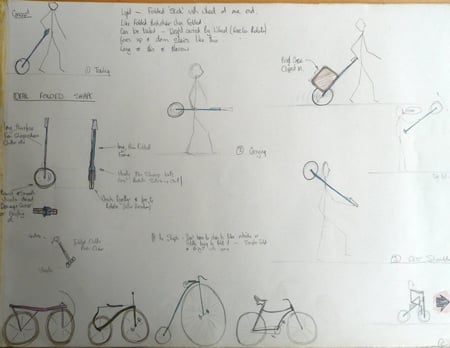
Bikes are just the perfect ‘human amplifiers’ and are right on this cusp between structures and design. Folding bikes make using public transport door-to-door, freeing people who are otherwise trapped into car use and helping those who need to link several transports.

Strida is pretty unique in the folding bike world due to its shape, simplicity and the fact that it can be wheeled along when folded. This makes it much easier to handle in the walking (i.e. non-riding) parts of a journey than conventional folding bikes, which get awfully heavy to carry, for example inside trains, down corridors and along platforms etc.

Dezeen: When the first one was designed, and how did it came about?
MS: It was my masters degree project, at London’s RCA in 1985 .

I conceived and designed the original Strida at a time when several things happened in my life…

I’d just given up a well-paid job to study a Masters at London’s RCA and Imperial College. I needed a major project for a year’s study to satisfy both colleges: basically the RCA had to be satisfied with the aesthetics and Imperial had to be satisfied with the mechanics.

I had a tough 25mile commute into London. I tried everything: by car the journey was slow and there was lots of congestion; by bus it was slow, congestion was still a problem and there was more than two miles extra to get to the door; by train the journey was ok, except for the last two miles to the door; by motorbike it was dangerous; and finally I tried cycling all the way, which would have been ok except it was totally knackering and nobody would sit near me when I got there!

Plus, on an even more personal note I wanted a project to help me to start my own design business: it had to be reasonably commercial.

Finally, I was highly motivated because my brother had just been killed in a stupid accident, so I wanted to make most of my time.

Having considered buying a folding bike to take on the train or bus I couldn’t find one that was affordable, fun, simple and light… in short I couldn’t find one that was at all appealing.

I believe that unless an innovation is appealing, it will change few lives.
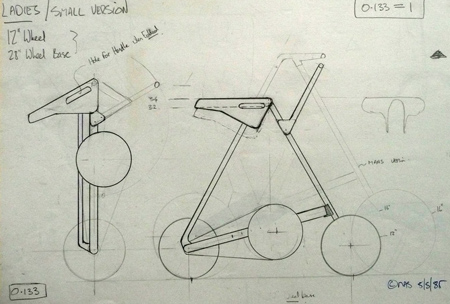
I felt that for me to design a new, simple and fun folding bike would meet all these needs.


My professor at the time however, Frank Height, didn’t agree and wanted to see evidence of a good concept before letting me go ahead.

His reaction was: “bikes were designed 100 years ago… what makes you think you can do anything new and innovative?” This was a good question and another challenge. He was later hugely supportive.

At the time taking full sized bikes on crowded commuter trains and buses just did not work well. Folding bikes were in their infancy and all were heavy and complex: they were usually just ‘fold in half’ jobs.

‘Green’ was not at all mainstream and bikes (this is before mountain bikes) were either for enthusiasts or for those who couldn’t afford a car.

I originally hit on the idea for a triangular frame by doing zillions of sketches and some sketch models of all the alternatives.

I needed something different and innovative for my professor. The triangle has elegance in both engineering and design terms, so I was happy.

The bike is basically 3 tubes and 3 joints. I feel lucky that they also formed such a distinctive visual statement – a triangle with wheels at its corners.

Regarding the mono-blade single-sided wheel mountings – most people’s reaction is to say “what about strength?”, but when you think that side mounted wheel axles only take a proportion of the rider’s weight and yet another bike part mounted on a monoblade (the pedal mounting) takes 100% of a rider’s load it makes sense.

Dezeen: When did it go on sale?
MS: The first Strida1 was sold 20 years ago, 18 months after my graduation show. Strida3, a major re-design, was launched in 2001-2.

Strida5 was launched last year in the Far East only, close to manufacturers Ming Cycle in Taiwan.

Dezeen: Where is the Strida company based?
MS: Up until recently, Strida company was a virtual company. The owner, Steedman Bass (a Bostonian), travelling where needed. Design was done by me in the UK, manufacture was carried out in Taiwan and distribution was world wide.
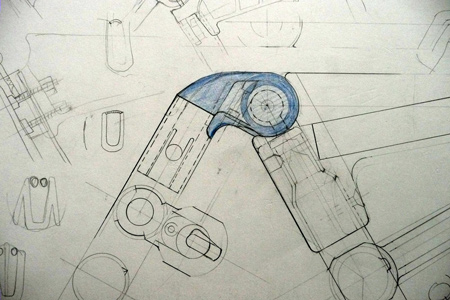
Now manufacturers Ming-cycle (one of the five biggest global bike makers, mainly OEM), own all of the IP, Strida brand etc. They also get to veto future designs, as I gave up the rights years ago.









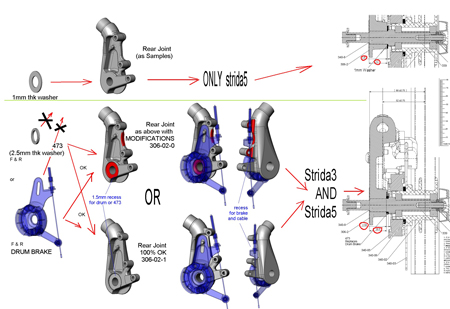

Algo mas de esto...
bicicletas,
proceso creativo
Suscribirse a:
Comentarios (Atom)




